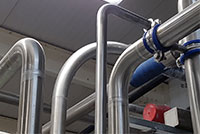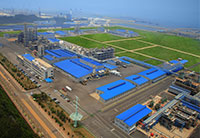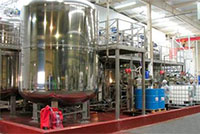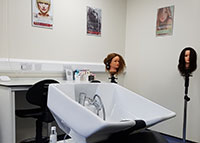8 Sep 2017
Silicones, or polysiloxanes, are oligomers or polymers incorporating a backbone of repeating siloxane (-Si-O-Si-) linkages - associated with organic groups. The term silicone was introduced by the British chemist, Frederic Stanley Kipping FRS (1863-1949), Professor of Chemistry at the then University College, Nottingham, and an early member of the SCI.1 Kipping synthesized and characterised a large number of organosilicon compounds over a period of more than thirty years and thought, initially, that the repeating ‘monomer’ in polysiloxanes was that of the silicon analogue of a ketone group, where the oxygen atom was attached to the silicon atoms by a double bond.2 However, the term silicone has remained in general use ever since, many years after the correct structure of silicones was first elucidated. Owing to their relative inertness and thermal stability, silicones are the materials of choice in a wide range of industrial applications.
Top image: Emulsification vessels

Image: Pipes for transfer of liquids and powders (powders require a more gentle curve)
On Tuesday 16 May 2017, SCI members and guests were given the opportunity to visit KCC Basildon’s Abingdon site. Our visit commenced with an introductory presentation about silicones, silicone emulsions and their properties by Michael Southon, the Company’s Technology Manager for Innovation and Platform Development. We were next given a tour around two manufacturing areas, the personal care plant (“PCP”) and the antifoam plant (“AFP”).
Image: Bulk storage vessels in antifoam production
Products are manufactured and stored in purpose made stainless vessels. These vary in volume between 0.5 and 32 tonnes and are either process vessels (PVs), in which products are made, or bulk storage (BS) vessels. The PVs are optimised for each product type and fitted with paddle stirrers, and are further equipped to refine emulsions or other suspended material to the required particle size, or to otherwise alter or modify the contents of the vessel. Vessels are automated and controlled by a touch-screen input and, subject to the demand for different products, are in 24 hour operation being overseen by staff on shifts. Completed batches are either discharged directly to fill containers for sale (for example 25 kg, or 1 tonne polythene containers, or containers up to the size of road tankers), or transferred to a BS vessel for later packing or further processing. Water is supplied via an onsite reverse osmosis system.
We were then shown around the development and quality control laboratories and the adjacent personal care product testing “salon” by Dr Lyndsey Mooring, Technical Section Leader. Analytical equipment is routinely used, for example FT-IR, various viscometers and particle size analysers for testing compounds and emulsions. In addition there is application specific instrumentation, such as Contifoam for measuring antifoam performance in a wide range of substrates. Further analytical and test equipment is available at Basildon or at KCC in Korea.
Image: Hair care salon – Whitney and Britney
In the newly installed “Salon”, products are trialled on both people and on hair tresses. Visual and tactile tests are performed manually and with test equipment. For example, the Dia-Stron is used for measuring combing performance of products applied to hair tresses. Silicones with functional side groups have certain properties that are modified by the functionality chosen. Amino functional silicones give enhanced deposition and substantivity when used on hair, while alkyl functional silicones (which can be designed to melt close to the temperature of the skin) modify the feel of skin care formulations.

Image: KCC Daejuk, Korea silicone plant
References:- JSCI, Vol XIX - 1900, List of Members, dated 31 January 1900.
- E. G. Rochow, Silicon and Silicones, Springer-Verlag, Berlin, 1987.*
- KCC Basildon,http://www.baschem.co.uk/about-us/, (accessed July 2017).
- KCC Basildon, http://www.baschem.co.uk/about-us/history/, (accessed July 2017).
*A lively and lucid introduction to the subject, interspersed with some amusing “personal vignettes”. Eugene Rochow developed what was to become known as the Rochow Synthesis while working at the General Electric Company Laboratories in Schenectady, New Jersey, USA in the early 1940s.
Julian Perfect
London Regional Group Committee
I would like to acknowledge our thanks to Michael Southon and Lyndsey Mooring for organising this excellent visit for the London Regional Group.


